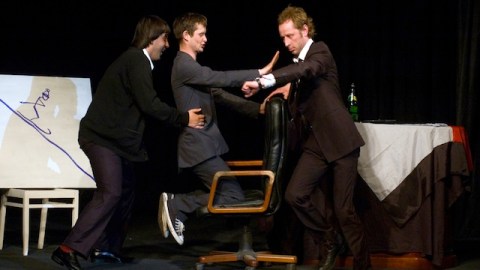What Improv Teaches Us About Creativity

The most important rule in improvisation comedy is the idea of agreement, the notion that a scene flourishes when all the players accept anything that happens to them. Improv isn’t about wisecracks and one-liners. It’s about creating a structure where characters and narratives are quickly created, developed, sometimes forgotten and other times resolved. With just a tip-bit – usually a one-word suggestion at the beginning of the show – good improvisers generate compelling and captivating stories that engage the audience. Comedy is the natural byproduct.
The question, of course, is how do they do it?
Consider a study conducted several years ago out of Johns Hopkins University by neuroscientist Charles Limb. Limb designed a clever experiment that measured the brains’ of jazz pianists using an fMRI machine as they improvised on a MIDI keyboard. His study focused on two parts of the brain: the medial prefrontal cortex (MPC) and the dorsolateral prefrontal cortex (DLPFC). The medial prefrontal cortex is a part of the brain associated with self-expression; it’s a mental narrator that keeps tabs on the story of your life. The DLPFC is closely associated with impulse control. It’s a part of the brain that makes you think twice before you eat a slice of pizza or gamble – a sort of mental shackle that keeps your neurons in check.
The key finding involved the DLPFC. Limb found that the musicians “deactivated” their DLPFC once they began improvising. That is, the musicians turned off part of their conscious brain to let the unconscious mind do the work. As Limb says, “musical creativity vis-à-vis improvisation may be a result of… the suspension of self-monitoring and related processes that typically regulate conscious control of goal-directed, predictable, or planned actions.” In other words, the pianists were inhibiting their inhibitions. (Watch Limb’s TED lecture here)
In a study with similar implications, researchers from the University of Illinois at Chicago examined the relationship between alcohol and creativity. The scientists gave several insight puzzles to two groups of students: one sober and one drunk. (They defined drunk as having a blood alcohol level of .075). The insight problems were a series of remote associate tests. For example, what word unifies the following three words?
Crab Sauce Pine
The answer, if you don’t have it already, is “Apple.” Remarkably, the scientists found that the drunken students solved more of these word problems (and faster) than the sober students. (The tipsy students were also more likely to perceive their solutions as the result of a sudden insight). Specifically, those intoxicated were 30 percent more likely to solve the problems.
Why? It goes back to Limb’s findings. The conscious mind has its strengths, but free flowing creative expression isn’t one of them. A lot of creativity is about relaxing your neurons so they can form new connections that deliberate thinking would otherwise block. It’s about turning off the analytical brain. Sometimes alcohol helps this process (for those of us who can’t quiet the DLPFC without outside stimuli unlike the musicians in Limb’s study). That’s not to suggest taking shots before art class, but it is to point out the creative benefits of letting your inhibitions go.
And this brings me back to improv. The aforementioned research confirms what great improvisers already know: rational and deliberate thinking are a bane on humor; people who try to be funny usually aren’t. This is why saying yes in improv is so important. A weighing of the pros and cons will surely kill the comedy – let the unconscious mind do the work.
A great quote from Keith Johnstone, one of the founders of improv theater captures this:
In life, most of us are highly skilled at suppressing action. All the improvisation teacher has to do is to reverse this skill and he creates very gifted improvisers. Bad improvisers block action, often with a high degree of skill. Good improvisers develop action. (From Gladwell’s Blink)
To be sure, being a great improviser is not just about “going with it.” It takes years of deliberate practice to master the nuance. Like a great athlete, becoming automatic – that magical ability to perform without even thinking about it – is the result of repeated failure and frustration. But once the 10,000 hours are put in, the unconscious mind should be doing most of the work.
Igor Bulgarin/Shutterstock.com





